Introduction to Python Part-1
Download as PPTX, PDF8 likes727 views
First in the series of slides for python programming, covering topics like programming language, python programming constructs, loops and control statements.
1 of 33
Downloaded 60 times
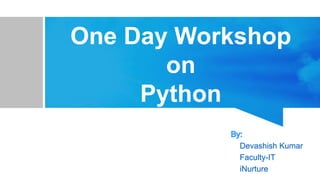
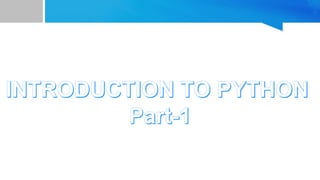

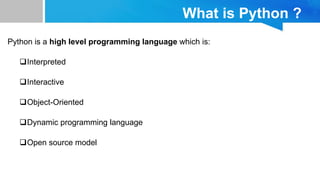
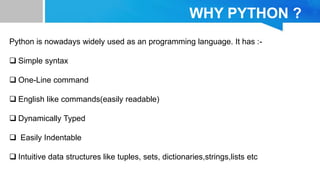
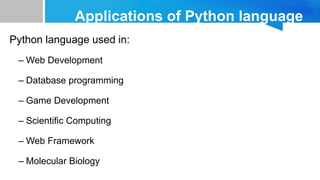


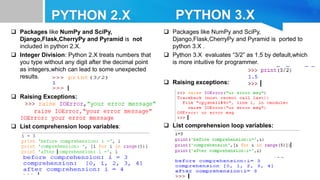


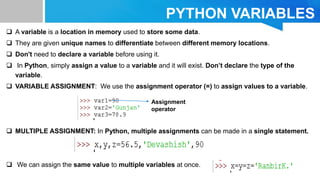
![NUMBERS
Number data types store numeric values.
They are immutable data types.
Number objects are created when you assign a value to them.
We can delete the reference to a number object by using the del statement.
Syntax: del var1[,var2[,var3[...., varN]]]]
We can delete a single object or multiple objects by using the del statement.](https://image.slidesharecdn.com/pythonbasicspart-1-171101092135/85/Introduction-to-Python-Part-1-13-320.jpg)
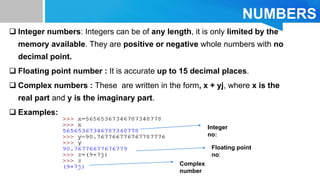

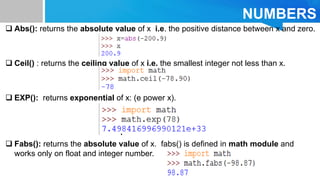







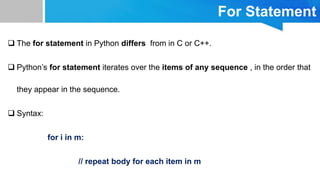

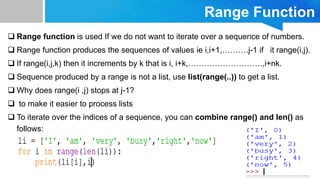
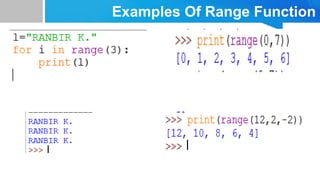


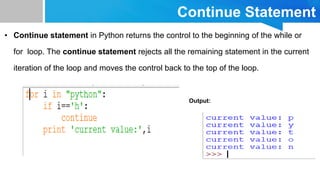
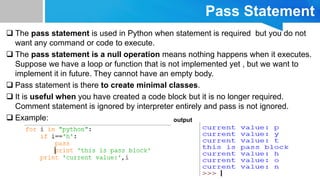


Ad
Recommended
Variables & Data Types In Python | Edureka



Variables & Data Types In Python | EdurekaEdureka! YouTube Link: https://youtu.be/6yrsX752CWk
(** Python Certification Training: https://www.edureka.co/python **)
This Edureka PPT on 'Variables and Data Types in Python' will help you establish a foothold on Python by helping you learn basic concepts like variables and data types. Below are the topics covered in this PPT:
Introduction To Python
Applications Of Python
Variable Declaration
Variable Data Types
Type Conversion
Python Tutorial Playlist: https://goo.gl/WsBpKe
Blog Series: http://bit.ly/2sqmP4s
Follow us to never miss an update in the future.
YouTube: https://www.youtube.com/user/edurekaIN
Instagram: https://www.instagram.com/edureka_learning/
Facebook: https://www.facebook.com/edurekaIN/
Twitter: https://twitter.com/edurekain
LinkedIn: https://www.linkedin.com/company/edureka
String matching, naive,



String matching, naive,Amit Kumar Rathi This document discusses string matching algorithms. It begins with an introduction to the naive string matching algorithm and its quadratic runtime. Then it proposes three improved algorithms: FC-RJ, FLC-RJ, and FMLC-RJ, which attempt to match patterns by restricting comparisons based on the first, first and last, or first, middle, and last characters, respectively. Experimental results show that these three proposed algorithms outperform the naive algorithm by reducing execution time, with FMLC-RJ working best for three-character patterns.
Nand and nor



Nand and norZahida Pervaiz This document discusses NAND and NOR gates as universal gates. It explains that NAND and NOR gates are universal because all other logic gates can be implemented using only NAND or NOR gates. It then provides examples of how to construct NOT, AND, OR, XOR, and XNOR gates using only NAND gates and how to construct NOT, OR, AND, NAND, XOR, and XNOR gates using only NOR gates.
Automata



AutomataGaditek The document provides information about a course on the theory of automata. It includes details such as the course title, prerequisites, duration, lectures, laboratories, and topics to be covered. The topics include finite automata, deterministic finite automata, non-deterministic finite automata, regular expressions, properties of regular languages, context-free grammars, pushdown automata, and Turing machines. It also lists reference books and textbooks, and the marking scheme for the course.
Lecture 3 RE NFA DFA 



Lecture 3 RE NFA DFA Rebaz Najeeb This document discusses lexical analysis in compilers. It begins with an outline of the topics to be covered, including lexical analysis, regular expressions, finite state automata, and the process of converting regular expressions to deterministic finite automata (DFAs). It then provides more details on each phase of a compiler and the role of lexical analysis. Key aspects of lexical analysis like tokenizing source code and classifying tokens are explained. The document also covers implementation of regular expressions using non-deterministic finite automata (NFAs) and their conversion to equivalent DFAs using techniques like epsilon-closure and transition tables.
FYBSC IT Digital Electronics Unit II Chapter I Boolean Algebra and Logic Gates



FYBSC IT Digital Electronics Unit II Chapter I Boolean Algebra and Logic GatesArti Parab Academics Boolean Algebra and Logic Gates:
Introduction, Logic (AND OR NOT), Boolean theorems, Boolean
Laws, De Morgan’s Theorem, Perfect Induction, Reduction of Logic
expression using Boolean Algebra, Deriving Boolean expression from
given circuit, exclusive OR and Exclusive NOR gates, Universal Logic
gates, Implementation of other gates using universal gates, Input
bubbled logic, Assertion level.
Rabin karp string matching algorithm



Rabin karp string matching algorithmGajanand Sharma The Rabin-Karp string matching algorithm calculates a hash value for the pattern and for each substring of the text to compare values efficiently. If hash values match, it performs a character-by-character comparison, otherwise it skips to the next substring. This reduces the number of costly comparisons from O(MN) in brute force to O(N) on average by filtering out non-matching substrings in one comparison each using hash values. Choosing a large prime number when calculating hash values further decreases collisions and false positives.
Decimal number system



Decimal number systemNisarg Amin The document discusses decimal and hexadecimal number systems. The decimal system uses 10 symbols (0-9) in a positional notation where the value of each digit depends on its position. Hexadecimal uses 16 symbols (0-9 plus A-F) with a base of 16. To convert between number systems, the integer and fractional parts are converted separately by repeated division or multiplication by the new base. For example, to convert decimal 765.245 to hexadecimal, 765 divides into 16 with remainder 13 and fractional part 0.245 is multiplied by 16 repeatedly.
NLP_KASHK:Finite-State Automata



NLP_KASHK:Finite-State AutomataHemantha Kulathilake The document discusses finite state automata (FSA) and regular expressions. It provides examples of deterministic and non-deterministic FSA that recognize strings containing combinations of words. Non-deterministic FSA can have multiple possible state transitions for a given input, requiring strategies like backing up, look-ahead, or parallel processing to determine if a string is accepted. FSA and regular expressions can define regular languages by generating all matching strings.
Python Loops Tutorial | Python For Loop | While Loop Python | Python Training...



Python Loops Tutorial | Python For Loop | While Loop Python | Python Training...Edureka! This document discusses loops in Python. It begins by explaining why loops are useful, such as for payroll processing to calculate salaries and bonuses for multiple employees. It then defines loops as allowing code to execute repeatedly based on conditional statements. The document outlines the main types of loops in Python - while loops, for loops, and nested loops. While loops iterate until a condition is false, for loops iterate a specified number of times, and nested loops involve loops within other loops. Examples are provided for each loop type, such as a guessing game to demonstrate a while loop and calculating factorials with a for loop.
Zero to Hero - Introduction to Python3



Zero to Hero - Introduction to Python3Chariza Pladin This presentation is a great resource for zero-based Python programmers who wants to learn Python 3. This course includes brief history of Python and familiarity of its basic syntax.
Boolean Algebra



Boolean AlgebraHau Moy Because binary logic is used in all of today´s digital computers and devices, the cost of the circuit that implement it is important factor addressed by designers- be they computer engineers, electrical engineers, or computer scientist.
NLP_KASHK:Minimum Edit Distance



NLP_KASHK:Minimum Edit DistanceHemantha Kulathilake The document discusses minimum edit distance and how it can be used to quantify the similarity between two strings. Minimum edit distance is defined as the minimum number of editing operations like insertion, deletion, substitution needed to transform one string into another. Levenshtein distance assigns a cost of 1 to each insertion, deletion, or substitution, and calculates the minimum edits between two strings using dynamic programming to build up solutions from sub-problems. The algorithm can also be modified to produce an alignment between the strings by storing back pointers and doing a backtrace.
Basics of Verilog.ppt



Basics of Verilog.pptCoEBMSITM The document provides an overview of Verilog HDL, including:
- Verilog HDL was invented in 1983/1984 and allows specification of digital systems at various levels of abstraction.
- It includes constructs for behavioral, algorithmic, register transfer, structural, and gate-level modeling.
- A basic Verilog module defines ports, data types, and functionality or structure. Modules can be instantiated as objects to build larger designs.
- The document outlines key Verilog concepts like modules, instances, data types, identifiers, keywords, and modeling approaches like behavioral and structural.
Pumping lemma for regular set h1



Pumping lemma for regular set h1Rajendran This document summarizes a lecture on automata theory, specifically discussing non-regular languages, the pumping lemma, and regular expressions. It introduces the language B={0n1n | n ≥ 0} as a non-regular language that cannot be recognized by a DFA. It then proves the pumping lemma theorem and uses it to show that B and the language of strings with equal numbers of 0s and 1s are non-regular. Finally, it defines regular expressions as a way to describe languages and provides examples of regular expressions and their meanings.
Lec 02 logical eq (Discrete Mathematics)



Lec 02 logical eq (Discrete Mathematics)Naosher Md. Zakariyar This lecture covers propositional equivalences like tautology and contradiction, logical equivalences that have the same truth values, De Morgan's law, and predicates and quantifiers. Predicates assign properties to variables, and quantifiers like the universal and existential quantifier specify whether a property holds for all or some variables. The lecture also discusses binding variables and nested quantified expressions.
Introduction to the basics of Python programming (part 1)



Introduction to the basics of Python programming (part 1)Pedro Rodrigues These are the slides of the first event of the meetup group Learn Python Den Haag. It covers some aspects of the basics of Python programming.
Python Crash Course



Python Crash CourseHaim Michael These are the slides I was using when delivering the Python Crash Course (https://www.meetup.com/life-michael/events/247984087/). The crash course was delivered in Hebrew. More info about the Python Programming course I deliver can be found at python.course.lifemichael.com.
Comparators in DLD.



Comparators in DLD.Zain Jafri The document discusses comparators, which are combinational logic circuits that compare the magnitudes of two binary numbers and determine their relationship. It describes 1-bit, 2-bit, and 4-bit comparators and how they use logic gates like XOR gates to compare bits and output if the numbers are equal, if the first is greater than the second, or if the first is less than the second. Larger comparators can be built by cascading multiple comparator circuits to compare numbers with more bits.
Number_Systems_and_Boolean_Algebra.ppt



Number_Systems_and_Boolean_Algebra.pptVEERA BOOPATHY E Number Systems - Arithmetic Operations - Binary Codes- Boolean Algebra and Logic Gates - Theorems and Properties of Boolean Algebra - Boolean Functions - Canonical and Standard Forms - Simplification of Boolean Functions using Karnaugh Map - Logic Gates – NAND and NOR Implementations.
Lecture-2(2): Number System & Conversion



Lecture-2(2): Number System & ConversionMubashir Ali This document provides an overview of different number systems including decimal, binary, octal, and hexadecimal. It discusses how each system uses a base (such as 10 for decimal, 2 for binary, 8 for octal, 16 for hexadecimal) and symbols (such as 0-9 for decimal and 0-1 for binary) to represent values. The key methods of converting between these number systems, such as repeated division and multiplying place values, are also explained through examples. Important concepts like bits, bytes, and representing binary patterns electrically in computers are covered.
Python Basics | Python Tutorial | Edureka



Python Basics | Python Tutorial | EdurekaEdureka! Youtube Link: https://youtu.be/woVJ4N5nl_s
** Python Certification Training: https://www.edureka.co/data-science-python-certification-course **
This Edureka PPT on 'Python Basics' will help you understand what exactly makes Python special and covers all the basics of Python programming along with examples.
Follow us to never miss an update in the future.
YouTube: https://www.youtube.com/user/edurekaIN
Instagram: https://www.instagram.com/edureka_learning/
Facebook: https://www.facebook.com/edurekaIN/
Twitter: https://twitter.com/edurekain
LinkedIn: https://www.linkedin.com/company/edureka
Castbox: https://castbox.fm/networks/505?country=in
Knuth morris pratt string matching algo



Knuth morris pratt string matching algosabiya sabiya This document provides an overview of the Knuth-Morris-Pratt substring search algorithm. It defines the algorithm, describes its history and key components including the prefix function and KMP matcher. An example showing the step-by-step workings of the algorithm on a text and pattern is provided. The algorithm's linear runtime complexity of O(n+m) is compared to other string matching algorithms. Real-world applications including DNA sequence analysis and search engines are discussed.
Fundamentals of algorithms



Fundamentals of algorithmsAmit Kumar Rathi This document outlines the course content and structure for a class on Fundamentals of Algorithms. It includes:
1. The prerequisites for the class which include programming experience and familiarity with data structures.
2. An overview of the purpose and evaluation scheme for the class, which focuses on analyzing and designing algorithms rather than programming. Student work will be evaluated through tests, assignments, and other activities.
3. A list of topics to be covered including analysis of algorithms, data structures like trees and graphs, sorting techniques, and others. Reference books are also provided.
FLOW OF CONTROL-NESTED IFS IN PYTHON



FLOW OF CONTROL-NESTED IFS IN PYTHONvikram mahendra 1) The document discusses various Python flow control statements including if, if-else, nested if-else, and elif statements with examples of using these to check conditions and execute code blocks accordingly.
2) Examples include programs to check number comparisons, even/odd numbers, positive/negative numbers, and using nested if-else for multi-level checks like checking triangle validity.
3) The last few sections discuss using if-else statements to classify triangles as equilateral, isosceles, or scalene and to check if a number is positive, negative, or zero.
Splay trees



Splay treesAmaan Shaikh Splay trees are a type of self-adjusting binary search tree that optimizes access to frequently used elements. They have the potential to achieve better than O(log n) time bounds due to splaying operations that rotate frequently accessed nodes toward the root. There are two approaches to splaying - bottom-up splaying which uses three rotation cases (zig, zig-zag, zig-zig) to move a node to the root, and top-down splaying which starts at the top and recombines subtrees. Splay trees are used for operations like find, delete minimum, and removal through these splaying techniques.
FYBSC IT Digital Electronics Unit I Chapter II Number System and Binary Arith...



FYBSC IT Digital Electronics Unit I Chapter II Number System and Binary Arith...Arti Parab Academics Binary Arithmetic:
Binary addition, Binary subtraction, Negative number representation,
Subtraction using 1’s complement and 2’s complement, Binary
multiplication and division, Arithmetic in octal number system,
Arithmetic in hexadecimal number system, BCD and Excess – 3
arithmetic.
An application of 8085 register interfacing with LED



An application of 8085 register interfacing with LEDTaha Malampatti This ppt will guide you through the steps to interface a seven segment led with a 8085 microprocessor.
Python Decision Making And Loops.pdf



Python Decision Making And Loops.pdfNehaSpillai1 Python uses indentation to define code blocks for decision making statements like if, elif and else. The if statement executes code if a condition is true, elif allows checking multiple conditions, and else runs code if all conditions are false. Loops like while and for repeat code, with while looping until a condition is false and for iterating over a sequence. Nested loops can run inner loops multiple times during outer loop iterations. The else block after a for runs if all iterations complete without breaking from the loop.
Ad
More Related Content
What's hot (20)
NLP_KASHK:Finite-State Automata



NLP_KASHK:Finite-State AutomataHemantha Kulathilake The document discusses finite state automata (FSA) and regular expressions. It provides examples of deterministic and non-deterministic FSA that recognize strings containing combinations of words. Non-deterministic FSA can have multiple possible state transitions for a given input, requiring strategies like backing up, look-ahead, or parallel processing to determine if a string is accepted. FSA and regular expressions can define regular languages by generating all matching strings.
Python Loops Tutorial | Python For Loop | While Loop Python | Python Training...



Python Loops Tutorial | Python For Loop | While Loop Python | Python Training...Edureka! This document discusses loops in Python. It begins by explaining why loops are useful, such as for payroll processing to calculate salaries and bonuses for multiple employees. It then defines loops as allowing code to execute repeatedly based on conditional statements. The document outlines the main types of loops in Python - while loops, for loops, and nested loops. While loops iterate until a condition is false, for loops iterate a specified number of times, and nested loops involve loops within other loops. Examples are provided for each loop type, such as a guessing game to demonstrate a while loop and calculating factorials with a for loop.
Zero to Hero - Introduction to Python3



Zero to Hero - Introduction to Python3Chariza Pladin This presentation is a great resource for zero-based Python programmers who wants to learn Python 3. This course includes brief history of Python and familiarity of its basic syntax.
Boolean Algebra



Boolean AlgebraHau Moy Because binary logic is used in all of today´s digital computers and devices, the cost of the circuit that implement it is important factor addressed by designers- be they computer engineers, electrical engineers, or computer scientist.
NLP_KASHK:Minimum Edit Distance



NLP_KASHK:Minimum Edit DistanceHemantha Kulathilake The document discusses minimum edit distance and how it can be used to quantify the similarity between two strings. Minimum edit distance is defined as the minimum number of editing operations like insertion, deletion, substitution needed to transform one string into another. Levenshtein distance assigns a cost of 1 to each insertion, deletion, or substitution, and calculates the minimum edits between two strings using dynamic programming to build up solutions from sub-problems. The algorithm can also be modified to produce an alignment between the strings by storing back pointers and doing a backtrace.
Basics of Verilog.ppt



Basics of Verilog.pptCoEBMSITM The document provides an overview of Verilog HDL, including:
- Verilog HDL was invented in 1983/1984 and allows specification of digital systems at various levels of abstraction.
- It includes constructs for behavioral, algorithmic, register transfer, structural, and gate-level modeling.
- A basic Verilog module defines ports, data types, and functionality or structure. Modules can be instantiated as objects to build larger designs.
- The document outlines key Verilog concepts like modules, instances, data types, identifiers, keywords, and modeling approaches like behavioral and structural.
Pumping lemma for regular set h1



Pumping lemma for regular set h1Rajendran This document summarizes a lecture on automata theory, specifically discussing non-regular languages, the pumping lemma, and regular expressions. It introduces the language B={0n1n | n ≥ 0} as a non-regular language that cannot be recognized by a DFA. It then proves the pumping lemma theorem and uses it to show that B and the language of strings with equal numbers of 0s and 1s are non-regular. Finally, it defines regular expressions as a way to describe languages and provides examples of regular expressions and their meanings.
Lec 02 logical eq (Discrete Mathematics)



Lec 02 logical eq (Discrete Mathematics)Naosher Md. Zakariyar This lecture covers propositional equivalences like tautology and contradiction, logical equivalences that have the same truth values, De Morgan's law, and predicates and quantifiers. Predicates assign properties to variables, and quantifiers like the universal and existential quantifier specify whether a property holds for all or some variables. The lecture also discusses binding variables and nested quantified expressions.
Introduction to the basics of Python programming (part 1)



Introduction to the basics of Python programming (part 1)Pedro Rodrigues These are the slides of the first event of the meetup group Learn Python Den Haag. It covers some aspects of the basics of Python programming.
Python Crash Course



Python Crash CourseHaim Michael These are the slides I was using when delivering the Python Crash Course (https://www.meetup.com/life-michael/events/247984087/). The crash course was delivered in Hebrew. More info about the Python Programming course I deliver can be found at python.course.lifemichael.com.
Comparators in DLD.



Comparators in DLD.Zain Jafri The document discusses comparators, which are combinational logic circuits that compare the magnitudes of two binary numbers and determine their relationship. It describes 1-bit, 2-bit, and 4-bit comparators and how they use logic gates like XOR gates to compare bits and output if the numbers are equal, if the first is greater than the second, or if the first is less than the second. Larger comparators can be built by cascading multiple comparator circuits to compare numbers with more bits.
Number_Systems_and_Boolean_Algebra.ppt



Number_Systems_and_Boolean_Algebra.pptVEERA BOOPATHY E Number Systems - Arithmetic Operations - Binary Codes- Boolean Algebra and Logic Gates - Theorems and Properties of Boolean Algebra - Boolean Functions - Canonical and Standard Forms - Simplification of Boolean Functions using Karnaugh Map - Logic Gates – NAND and NOR Implementations.
Lecture-2(2): Number System & Conversion



Lecture-2(2): Number System & ConversionMubashir Ali This document provides an overview of different number systems including decimal, binary, octal, and hexadecimal. It discusses how each system uses a base (such as 10 for decimal, 2 for binary, 8 for octal, 16 for hexadecimal) and symbols (such as 0-9 for decimal and 0-1 for binary) to represent values. The key methods of converting between these number systems, such as repeated division and multiplying place values, are also explained through examples. Important concepts like bits, bytes, and representing binary patterns electrically in computers are covered.
Python Basics | Python Tutorial | Edureka



Python Basics | Python Tutorial | EdurekaEdureka! Youtube Link: https://youtu.be/woVJ4N5nl_s
** Python Certification Training: https://www.edureka.co/data-science-python-certification-course **
This Edureka PPT on 'Python Basics' will help you understand what exactly makes Python special and covers all the basics of Python programming along with examples.
Follow us to never miss an update in the future.
YouTube: https://www.youtube.com/user/edurekaIN
Instagram: https://www.instagram.com/edureka_learning/
Facebook: https://www.facebook.com/edurekaIN/
Twitter: https://twitter.com/edurekain
LinkedIn: https://www.linkedin.com/company/edureka
Castbox: https://castbox.fm/networks/505?country=in
Knuth morris pratt string matching algo



Knuth morris pratt string matching algosabiya sabiya This document provides an overview of the Knuth-Morris-Pratt substring search algorithm. It defines the algorithm, describes its history and key components including the prefix function and KMP matcher. An example showing the step-by-step workings of the algorithm on a text and pattern is provided. The algorithm's linear runtime complexity of O(n+m) is compared to other string matching algorithms. Real-world applications including DNA sequence analysis and search engines are discussed.
Fundamentals of algorithms



Fundamentals of algorithmsAmit Kumar Rathi This document outlines the course content and structure for a class on Fundamentals of Algorithms. It includes:
1. The prerequisites for the class which include programming experience and familiarity with data structures.
2. An overview of the purpose and evaluation scheme for the class, which focuses on analyzing and designing algorithms rather than programming. Student work will be evaluated through tests, assignments, and other activities.
3. A list of topics to be covered including analysis of algorithms, data structures like trees and graphs, sorting techniques, and others. Reference books are also provided.
FLOW OF CONTROL-NESTED IFS IN PYTHON



FLOW OF CONTROL-NESTED IFS IN PYTHONvikram mahendra 1) The document discusses various Python flow control statements including if, if-else, nested if-else, and elif statements with examples of using these to check conditions and execute code blocks accordingly.
2) Examples include programs to check number comparisons, even/odd numbers, positive/negative numbers, and using nested if-else for multi-level checks like checking triangle validity.
3) The last few sections discuss using if-else statements to classify triangles as equilateral, isosceles, or scalene and to check if a number is positive, negative, or zero.
Splay trees



Splay treesAmaan Shaikh Splay trees are a type of self-adjusting binary search tree that optimizes access to frequently used elements. They have the potential to achieve better than O(log n) time bounds due to splaying operations that rotate frequently accessed nodes toward the root. There are two approaches to splaying - bottom-up splaying which uses three rotation cases (zig, zig-zag, zig-zig) to move a node to the root, and top-down splaying which starts at the top and recombines subtrees. Splay trees are used for operations like find, delete minimum, and removal through these splaying techniques.
FYBSC IT Digital Electronics Unit I Chapter II Number System and Binary Arith...



FYBSC IT Digital Electronics Unit I Chapter II Number System and Binary Arith...Arti Parab Academics Binary Arithmetic:
Binary addition, Binary subtraction, Negative number representation,
Subtraction using 1’s complement and 2’s complement, Binary
multiplication and division, Arithmetic in octal number system,
Arithmetic in hexadecimal number system, BCD and Excess – 3
arithmetic.
An application of 8085 register interfacing with LED



An application of 8085 register interfacing with LEDTaha Malampatti This ppt will guide you through the steps to interface a seven segment led with a 8085 microprocessor.
FYBSC IT Digital Electronics Unit I Chapter II Number System and Binary Arith...



FYBSC IT Digital Electronics Unit I Chapter II Number System and Binary Arith...Arti Parab Academics
Similar to Introduction to Python Part-1 (20)
Python Decision Making And Loops.pdf



Python Decision Making And Loops.pdfNehaSpillai1 Python uses indentation to define code blocks for decision making statements like if, elif and else. The if statement executes code if a condition is true, elif allows checking multiple conditions, and else runs code if all conditions are false. Loops like while and for repeat code, with while looping until a condition is false and for iterating over a sequence. Nested loops can run inner loops multiple times during outer loop iterations. The else block after a for runs if all iterations complete without breaking from the loop.
Introduction to Python for Data Science and Machine Learning 



Introduction to Python for Data Science and Machine Learning ParrotAI This document provides an introduction and overview of Python for data science and machine learning. It covers basics of Python including what Python is, its features, why it is useful for data science. It also discusses installing Python, using the IDLE and Jupyter Notebook environments. The document then covers Python basics like variables, data types, operators, decision making and loops. Finally, it discusses collection data types like lists, tuples and dictionaries and functions in Python.
Unit - 2 CAP.pptx



Unit - 2 CAP.pptxmalekaanjum1 Operators and expressions are fundamental concepts in Python programming. The document discusses various types of operators used to manipulate operands, including arithmetic, comparison, assignment, logical, bitwise, and membership operators. It also covers expressions, which are combinations of operators and operands that evaluate to a value. Several types of expressions are described, such as constant, arithmetic, integral, floating, relational, logical, bitwise, and combinational expressions. Control flow statements like if, if-else, if-elif-else are also covered, along with looping using for and while loops and the break, continue, and pass statements.
Python Programming Course Presentations



Python Programming Course PresentationsDreamerInfotech Dreamer Infotech offers the best python programming course in Faridabad, We offer an exceptional learning experience with expert faculty, Comprehensive Curriculum, Hands-on Projects, and 100% Placement Assistance. We also organize recruitment drives and connect you with leading companies seeking data science professionals. So Don’t miss out on the opportunity to upscale your skills with the best Python Training Institute in Faridabad.
Python Session - 4



Python Session - 4AnirudhaGaikwad4 Python Session - 4
if
nested-if
if-else
elif (else if)
for loop (for iterating_var in sequence: )
while loop
break
continnue
pass
What is a function in Python?
Types of Functions
How to Define & Call Function
Scope and Lifetime of variables
lambda functions(anonymous functions)
Python



PythonAashish Jain This presentation provides the information on python including the topics Python features, applications, variables and operators in python, control statements, numbers, strings, print formatting, list and list comprehension, dictionaries, tuples, files, sets, boolean, mehtods and functions, lambda expressions and a sample project using Python.
GE3151 UNIT II Study material .pdf



GE3151 UNIT II Study material .pdfGuru Nanak Technical Institutions The document discusses various concepts related to data, expressions, and statements in Python programming. It begins by defining an interpreter as a program that executes instructions in a programming language. It then discusses invoking the Python interpreter in both script and interactive modes. In interactive mode, the interpreter provides immediate feedback for each statement. The document also defines various Python concepts like values and variables, keywords, expressions, operators, data types, functions, and control flow. It provides examples to illustrate function definition and calls, math functions, and basic Python programs to swap variables, check leap years, and convert Celsius to Fahrenheit.
Python revision tour i



Python revision tour iMr. Vikram Singh Slathia Computer Science with Python
Class XII
Unit I: Computational Thinking and Programming -2
Chapter 1: Review of Python basics I (Revision Tour Class XI)
Python interview questions and answers



Python interview questions and answersRojaPriya The document discusses Python interview questions and answers related to Python fundamentals like data types, variables, functions, objects and classes. Some key points include:
- Python is an interpreted, interactive and object-oriented programming language. It uses indentation to identify code blocks rather than brackets.
- Python supports dynamic typing where the type is determined at runtime. It is strongly typed meaning operations inappropriate for a type will fail with an exception.
- Common data types include lists (mutable), tuples (immutable), dictionaries, strings and numbers.
- Functions use def, parameters are passed by reference, and variables can be local or global scope.
- Classes use inheritance, polymorphism and encapsulation to create
Python interview questions and answers



Python interview questions and answerskavinilavuG Python is an interpreted, object-oriented programming language that uses indentation to identify blocks of code. It is dynamically typed and strongly typed, with objects determining types at runtime rather than requiring explicit type declaration. Common data types include mutable types like lists and dictionaries as well as immutable types like strings and tuples.
ppt3-conditionalstatementloopsdictionaryfunctions-240731050730-455ba0fa.ppt



ppt3-conditionalstatementloopsdictionaryfunctions-240731050730-455ba0fa.pptavishekpradhan24 dxtfdjfhf
program on python what is python where it was started by whom started



program on python what is python where it was started by whom startedrajkumarmandal9391 ppt on python
Review Python



Review PythonManishTiwari326 This document provides an overview of the Python programming language. It discusses what a program and programming language are, and then describes key features of Python like being simple, interactive, and object-oriented. It explains how to install Python and work in interactive and script modes. The document also covers Python concepts like variables, data types, functions, operators, and control structures like conditional statements and loops.
Ad
More from Devashish Kumar (7)
Python: Data Visualisation



Python: Data VisualisationDevashish Kumar In this set of slides we have picked some datasets and tried to analyse it contents based on some queries. Some contents are referred from internet(like sample dataset whose links are not attached)
Pandas csv



Pandas csvDevashish Kumar Deals with CSV Files operations in Pandas like reading, writing, performing joins and other operations in python using dataframes and Series in Pandas.
Data Analysis packages



Data Analysis packagesDevashish Kumar Pandas is a Python library used for data manipulation and analysis. It introduces two main data structures: Series and DataFrame. Series is a one-dimensional array-like object containing data and labels, while DataFrame is a spreadsheet-like structure containing an ordered collection of columns. NumPy must be installed before Pandas, SciPy, or other Python packages for scientific computing. These packages provide powerful tools for data analysis and visualization.
Data Analysis in Python-NumPy



Data Analysis in Python-NumPyDevashish Kumar First in the series of Data Analysis in Python. Upcoming series will cover the concepts of Scipy, Pandas, Metplotlib, StatsModels
Functions in python slide share



Functions in python slide shareDevashish Kumar The document discusses various concepts related to functions in Python including defining functions, passing arguments, default arguments, arbitrary argument lists, lambda expressions, function annotations, and documentation strings. Functions provide modularity and code reusability. Arguments can be passed by value or reference and default values are evaluated once. Keyword, arbitrary and unpacked arguments allow flexible calling. Lambda expressions define small anonymous functions. Annotations provide type metadata and docstrings document functions.
Data Structures in Python



Data Structures in PythonDevashish Kumar Data Structures in Python, second in the series of Introduction to Python. Upcoming series will cover Functions and OOPs concept in Python.
Cloud Computing Introductory-1



Cloud Computing Introductory-1Devashish Kumar Cloud computing provides on-demand access to computing resources like processing power, storage, and applications via the internet on a pay-as-you-go basis. It allows developers and IT departments to avoid undifferentiated work like procurement, maintenance, and capacity planning. There are three main types of cloud computing models - Infrastructure as a Service (IaaS) which provides basic computing resources, Platform as a Service (PaaS) which removes the need to manage underlying infrastructure, and Software as a Service (SaaS) which provides complete software packages managed by the service provider.
Ad
Recently uploaded (20)
Understanding P–N Junction Semiconductors: A Beginner’s Guide



Understanding P–N Junction Semiconductors: A Beginner’s GuideGS Virdi Dive into the fundamentals of P–N junctions, the heart of every diode and semiconductor device. In this concise presentation, Dr. G.S. Virdi (Former Chief Scientist, CSIR-CEERI Pilani) covers:
What Is a P–N Junction? Learn how P-type and N-type materials join to create a diode.
Depletion Region & Biasing: See how forward and reverse bias shape the voltage–current behavior.
V–I Characteristics: Understand the curve that defines diode operation.
Real-World Uses: Discover common applications in rectifiers, signal clipping, and more.
Ideal for electronics students, hobbyists, and engineers seeking a clear, practical introduction to P–N junction semiconductors.
High Performance Liquid Chromatography .pptx



High Performance Liquid Chromatography .pptxAyush Srivastava High-performance liquid chromatography (HPLC) is a sophisticated analytical technique used to separate, identify, and quantify the components of a mixture. It involves passing a sample dissolved in a mobile phase through a column packed with a stationary phase under high pressure, allowing components to separate based on their interaction with the stationary phase.
Separation:
HPLC separates components based on their differing affinities for the stationary phase. The components that interact more strongly with the stationary phase will move more slowly through the column, while those that interact less strongly will move faster.
Identification:
The separated components are detected as they exit the column, and the time at which each component exits the column can be used to identify it.
Quantification:
The area of the peak on the chromatogram (the graph of detector response versus time) is proportional to the amount of each component in the sample.
Principle:
HPLC relies on a high-pressure pump to force the mobile phase through the column. The high pressure allows for faster separations and greater resolution compared to traditional liquid chromatography methods.
Mobile Phase:
The mobile phase is a solvent or a mixture of solvents that carries the sample through the column. The composition of the mobile phase can be adjusted to optimize the separation of different components.
Stationary Phase:
The stationary phase is a solid material packed inside the column that interacts with the sample components. The type of stationary phase is chosen based on the properties of the components being separated.
Applications of HPLC:
Analysis of pharmaceutical compounds: HPLC is widely used for the analysis of drugs and their metabolites.
Environmental monitoring: HPLC can be used to analyze pollutants in water and soil.
Food chemistry: HPLC is used to analyze the composition of food products.
Biochemistry: HPLC is used to analyze proteins, peptides, and nucleic acids.
K12 Tableau Tuesday - Algebra Equity and Access in Atlanta Public Schools



K12 Tableau Tuesday - Algebra Equity and Access in Atlanta Public Schoolsdogden2 Algebra 1 is often described as a “gateway” class, a pivotal moment that can shape the rest of a student’s K–12 education. Early access is key: successfully completing Algebra 1 in middle school allows students to complete advanced math and science coursework in high school, which research shows lead to higher wages and lower rates of unemployment in adulthood.
Learn how The Atlanta Public Schools is using their data to create a more equitable enrollment in middle school Algebra classes.
UNIT 3 NATIONAL HEALTH PROGRAMMEE. SOCIAL AND PREVENTIVE PHARMACY



UNIT 3 NATIONAL HEALTH PROGRAMMEE. SOCIAL AND PREVENTIVE PHARMACYDR.PRISCILLA MARY J NATIONAL HEALTH PROGRAMMEE
Open Access: Revamping Library Learning Resources.



Open Access: Revamping Library Learning Resources.Rishi Bankim Chandra Evening College, Naihati, North 24 Parganas, West Bengal, India Dr. Santosh Kumar Tunga discussed an overview of the availability and the use of Open Educational Resources (OER) and its related various issues for various stakeholders in higher educational Institutions. Dr. Tunga described the concept of open access initiatives, open learning resources, creative commons licensing attribution, and copyright. Dr. Tunga also explained the various types of OER, INFLIBNET & NMEICT initiatives in India and the role of academic librarians regarding the use of OER.
Geography Sem II Unit 1C Correlation of Geography with other school subjects



Geography Sem II Unit 1C Correlation of Geography with other school subjectsProfDrShaikhImran The correlation of school subjects refers to the interconnectedness and mutual reinforcement between different academic disciplines. This concept highlights how knowledge and skills in one subject can support, enhance, or overlap with learning in another. Recognizing these correlations helps in creating a more holistic and meaningful educational experience.
Marie Boran Special Collections Librarian Hardiman Library, University of Gal...



Marie Boran Special Collections Librarian Hardiman Library, University of Gal...Library Association of Ireland Phoenix – A Collaborative Renewal of Children’s and Young People’s Services Clare Doyle - Cork City Libraries
Quality Contril Analysis of Containers.pdf



Quality Contril Analysis of Containers.pdfDr. Bindiya Chauhan Quality control test for containers, rubber closures and secondary packing materials.
Exploring-Substances-Acidic-Basic-and-Neutral.pdf



Exploring-Substances-Acidic-Basic-and-Neutral.pdfSandeep Swamy Exploring Substances:
Acidic, Basic, and
Neutral
Welcome to the fascinating world of acids and bases! Join siblings Ashwin and
Keerthi as they explore the colorful world of substances at their school's
National Science Day fair. Their adventure begins with a mysterious white paper
that reveals hidden messages when sprayed with a special liquid.
In this presentation, we'll discover how different substances can be classified as
acidic, basic, or neutral. We'll explore natural indicators like litmus, red rose
extract, and turmeric that help us identify these substances through color
changes. We'll also learn about neutralization reactions and their applications in
our daily lives.
by sandeep swamy
Studying Drama: Definition, types and elements



Studying Drama: Definition, types and elementsAbdelFattahAdel2 Studying Drama: Definition, types and elements
GDGLSPGCOER - Git and GitHub Workshop.pptx



GDGLSPGCOER - Git and GitHub Workshop.pptxazeenhodekar This presentation covers the fundamentals of Git and version control in a practical, beginner-friendly way. Learn key commands, the Git data model, commit workflows, and how to collaborate effectively using Git — all explained with visuals, examples, and relatable humor.
Envenomation---Clinical Toxicology. pptx



Envenomation---Clinical Toxicology. pptxrekhapositivity Envenomation is the process by which venom is injected by the bite or sting of a venomous animal such as a snake, scorpion, spider, or insect. Arthropod bite is nothing but a sharp bite or sting by ants, fruit flies, bees, beetles, moths, or hornets. Though not a serious condition, arthropod bite can be extremely painful, with redness and mild to severe swelling around the site of the bite
Unit 5: Dividend Decisions and its theories



Unit 5: Dividend Decisions and its theoriesbharath321164 decisions: meaning, factors influencing dividends, forms of dividends, dividend theories: relevance theory (Walter model, Gordon model), irrelevance theory (MM Hypothesis)
Unit 4: Long term- Capital budgeting and its types



Unit 4: Long term- Capital budgeting and its typesbharath321164 budgeting: meaning, significance, process, project classification, and investment criteria: payback method, ARR method, net present value, IRR method, profitability
LDMMIA Reiki Master Spring 2025 Mini Updates



LDMMIA Reiki Master Spring 2025 Mini UpdatesLDM Mia eStudios As of Mid to April Ending, I am building a new Reiki-Yoga Series. No worries, they are free workshops. So far, I have 3 presentations so its a gradual process. If interested visit: https://www.slideshare.net/YogaPrincess
https://ldmchapels.weebly.com
Blessings and Happy Spring. We are hitting Mid Season.
Ultimate VMware 2V0-11.25 Exam Dumps for Exam Success



Ultimate VMware 2V0-11.25 Exam Dumps for Exam SuccessMark Soia Boost your chances of passing the 2V0-11.25 exam with CertsExpert reliable exam dumps. Prepare effectively and ace the VMware certification on your first try
Quality dumps. Trusted results. — Visit CertsExpert Now: https://www.certsexpert.com/2V0-11.25-pdf-questions.html
To study the nervous system of insect.pptx



To study the nervous system of insect.pptxArshad Shaikh The *nervous system of insects* is a complex network of nerve cells (neurons) and supporting cells that process and transmit information. Here's an overview:
Structure
1. *Brain*: The insect brain is a complex structure that processes sensory information, controls behavior, and integrates information.
2. *Ventral nerve cord*: A chain of ganglia (nerve clusters) that runs along the insect's body, controlling movement and sensory processing.
3. *Peripheral nervous system*: Nerves that connect the central nervous system to sensory organs and muscles.
Functions
1. *Sensory processing*: Insects can detect and respond to various stimuli, such as light, sound, touch, taste, and smell.
2. *Motor control*: The nervous system controls movement, including walking, flying, and feeding.
3. *Behavioral responThe *nervous system of insects* is a complex network of nerve cells (neurons) and supporting cells that process and transmit information. Here's an overview:
Structure
1. *Brain*: The insect brain is a complex structure that processes sensory information, controls behavior, and integrates information.
2. *Ventral nerve cord*: A chain of ganglia (nerve clusters) that runs along the insect's body, controlling movement and sensory processing.
3. *Peripheral nervous system*: Nerves that connect the central nervous system to sensory organs and muscles.
Functions
1. *Sensory processing*: Insects can detect and respond to various stimuli, such as light, sound, touch, taste, and smell.
2. *Motor control*: The nervous system controls movement, including walking, flying, and feeding.
3. *Behavioral responses*: Insects can exhibit complex behaviors, such as mating, foraging, and social interactions.
Characteristics
1. *Decentralized*: Insect nervous systems have some autonomy in different body parts.
2. *Specialized*: Different parts of the nervous system are specialized for specific functions.
3. *Efficient*: Insect nervous systems are highly efficient, allowing for rapid processing and response to stimuli.
The insect nervous system is a remarkable example of evolutionary adaptation, enabling insects to thrive in diverse environments.
The insect nervous system is a remarkable example of evolutionary adaptation, enabling insects to thrive
Diabetic neuropathy peripheral autonomic



Diabetic neuropathy peripheral autonomicPankaj Patawari In this ppt I have tried to give basic idea about Diabetic peripheral and autonomic neuropathy ..from Levine textbook,IWGDF guideline etc
Hope it will b helpful for trainee and physician
Open Access: Revamping Library Learning Resources.



Open Access: Revamping Library Learning Resources.Rishi Bankim Chandra Evening College, Naihati, North 24 Parganas, West Bengal, India
Marie Boran Special Collections Librarian Hardiman Library, University of Gal...



Marie Boran Special Collections Librarian Hardiman Library, University of Gal...Library Association of Ireland
Introduction to Python Part-1
- 1. One Day Workshop on Python Devashish Kumar Faculty-IT iNurture
- 3. Programming Language A programming language is a notation for writing programs. A programming language is a computer language designed to communicate instructions to a machine, particularly a computer. Programming languages can be used to create programs, to control the behaviour of a machine or to express algorithms. Various programming languages are such as: c , c++ , R, java, C# , ruby , python etc.
- 4. What is Python ? Python is a high level programming language which is: Interpreted Interactive Object-Oriented Dynamic programming language Open source model
- 5. WHY PYTHON ? Python is nowadays widely used as an programming language. It has :- Simple syntax One-Line command English like commands(easily readable) Dynamically Typed Easily Indentable Intuitive data structures like tuples, sets, dictionaries,strings,lists etc
- 6. Applications of Python language Python language used in: – Web Development – Database programming – Game Development – Scientific Computing – Web Framework – Molecular Biology
- 7. WHY 2.7 RELEASE AFTER 3.X ? • Version 2.X has an awful quantity of useful libraries that haven’t been ported to 3.X version. • Current Linux distributions and Macs are still using 2.x as default. Some are phasing out Python 2 as preinstalled default. • Python 3 already broadly supports creating GUI applications, with Tkinter ,etc. in the standard library. • Python 2.7 provides a stable and a supported base platform for production system that have not yet been ported to Python 3.
- 8. In Python 2.X, range() and xrange() function is used for iterating and range() function behaves as it is a list. In Python 2.X, data type returned is in int,char etc. In python 2.X, no TypeError is raised if we try to compare unorderable type. Handling exception: In python 2.X, for handling exception in the syntax we use comma instead of ‘as’. In python 3.X, xrange() function is not used, it gives name error and range doesnot behave as a list. In python 3.x, data type returned is in class. In python 3.X, TypeError is raised as warning if we try to compare unorderable type. In python 3.X, for handling exception in the syntax we use ‘as’ keyword.
- 9. Packages like NumPy and SciPy, Django,Flask,CherryPy and Pyramid is not included in python 2.X. Integer Division: Python 2.X treats numbers that you type without any digit after the decimal point as integers,which can lead to some unexpected results. Raising Exceptions: List comprehension loop variables: Packages like NumPy and SciPy, Django,Flask,CherryPy and Pyramid is ported to python 3.X . Python 3.X evaluates “3/2” as 1.5 by default,which is more intuitive for programmer. Raising exceptions: List comprehension loop variables:
- 10. Future_module: this module is used to help in migration. .Next() function: Python 2.X supports .next() function. Output: Python 2.x has two integer types: int and long Future Module: .Next() function: Python 3.X doesn’t support “.next()” function. In Python 3.x, no long integer type is specified.
- 11. VARIABLES
- 12. PYTHON VARIABLES A variable is a location in memory used to store some data. They are given unique names to differentiate between different memory locations. Don't need to declare a variable before using it. In Python, simply assign a value to a variable and it will exist. Don’t declare the type of the variable. VARIABLE ASSIGNMENT: We use the assignment operator (=) to assign values to a variable. MULTIPLE ASSIGNMENT: In Python, multiple assignments can be made in a single statement. We can assign the same value to multiple variables at once. Assignment operator
- 13. NUMBERS Number data types store numeric values. They are immutable data types. Number objects are created when you assign a value to them. We can delete the reference to a number object by using the del statement. Syntax: del var1[,var2[,var3[...., varN]]]] We can delete a single object or multiple objects by using the del statement.
- 14. NUMBERS Integer numbers: Integers can be of any length, it is only limited by the memory available. They are positive or negative whole numbers with no decimal point. Floating point number : It is accurate up to 15 decimal places. Complex numbers : These are written in the form, x + yj, where x is the real part and y is the imaginary part. Examples: Integer no: Floating point no: Complex number
- 15. EXAMPLES OF NUMBER In interactive mode, the last printed expression is assigned to the variable _ Example: Division (/) always returns a float. To get an integer result, use floor division (//) To calculate the remainder you can use %:
- 16. NUMBERS Abs(): returns the absolute value of x i.e. the positive distance between x and zero. Ceil() : returns the ceiling value of x i.e. the smallest integer not less than x. EXP(): returns exponential of x: (e power x). Fabs(): returns the absolute value of x. fabs() is defined in math module and works only on float and integer number.
- 17. NUMBERS • Floor(): returns the floor of x i.e. the largest integer not greater than x. • Log(): returns the natural logarithm of x. • Log10(): returns base-10 logarithm of x for x > 0. • Max(): returns the largest of its arguments • There are many more functions that perform mathematical operations on numbers.
- 18. NUMBERS
- 19. Control Flow And Loops Various control statements are: if and else Elif For Range While Break Continue
- 20. IF AND ELSE STATEMENT • The syntax for if statement in python are: • For example: if (condition): #execution of an if statement statement1 statement2 else: #execution of an else statement statement1 statement2 • If we use else statement without using if statement then it will raise an error.
- 21. Example of If And Else Output:
- 22. Elif statement • Elif statement is similar to the else if statement used in c or c++. • Elif statement is a combination of else and if statement. • Syntax: if (condition): statement1 statement2 elif (condition): # elif is a combination of else if statement3 statement4 else: statement5 • There can be zero or more elif parts, and the else part is optional. The keyword ‘elif ‘ is short for ‘else if’, and is useful to avoid excessive indentation.
- 23. Example of Elif statement Output:
- 24. For Statement The for statement in Python differs from in C or C++. Python’s for statement iterates over the items of any sequence , in the order that they appear in the sequence. Syntax: for i in m: // repeat body for each item in m
- 25. Examples of For statement Output: Output Example 2:Example1:
- 26. Range Function Range function is used If we do not want to iterate over a sequence of numbers. Range function produces the sequences of values ie i,i+1,……….j-1 if it range(i,j). If range(i,j,k) then it increments by k that is i, i+k,……………………….,i+nk. Sequence produced by a range is not a list, use list(range(..)) to get a list. Why does range(i ,j) stops at j-1? to make it easier to process lists To iterate over the indices of a sequence, you can combine range() and len() as follows:
- 27. Examples Of Range Function
- 28. WHILE LOOP • While loop in Python is used to iterate over a block of code as long as the test expression(condition) is true. • Syntax: while condition: statement(s) //repeat body till condition becomes false • Loop might not ever run: When the condition is tested and the result is false then the loop body will be skipped and the first statement after the while loop is executed. • Example: output:
- 29. Break Statement The break statement in python terminates the current loop and resumes execution at the next statement , just like break statement in c. The break statement can be used in both for and while loops. Output:
- 30. Continue Statement • Continue statement in Python returns the control to the beginning of the while or for loop. The continue statement rejects all the remaining statement in the current iteration of the loop and moves the control back to the top of the loop. Output:
- 31. Pass Statement The pass statement is used in Python when statement is required but you do not want any command or code to execute. The pass statement is a null operation means nothing happens when it executes. Suppose we have a loop or function that is not implemented yet , but we want to implement it in future. They cannot have an empty body. Pass statement is there to create minimal classes. It is useful when you have created a code block but it is no longer required. Comment statement is ignored by interpreter entirely and pass is not ignored. Example: output
- 32. VARIABLES
- 33. CONTRIBUTERS









